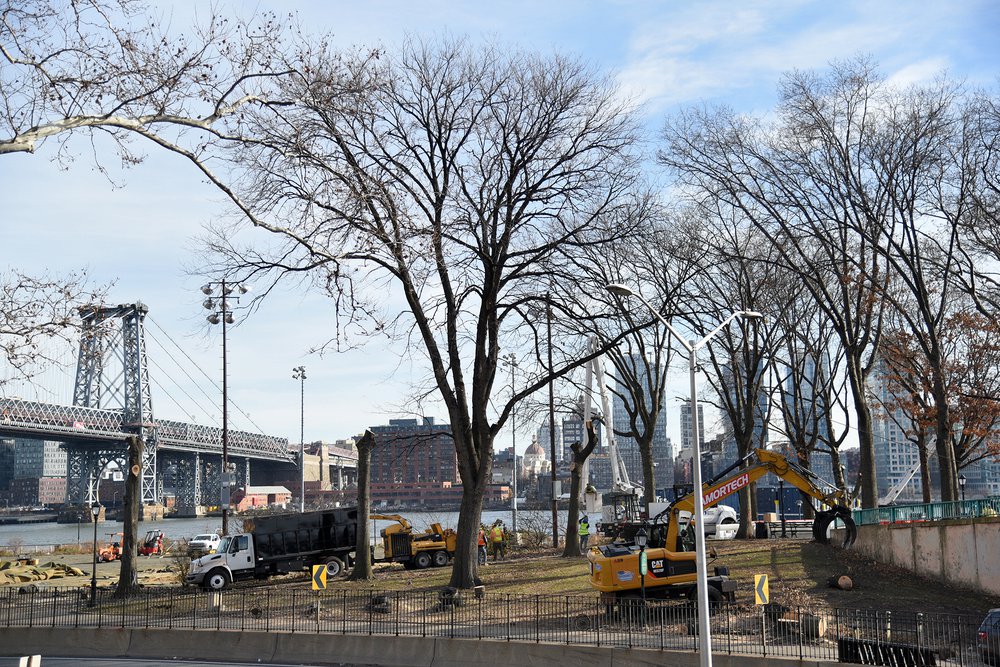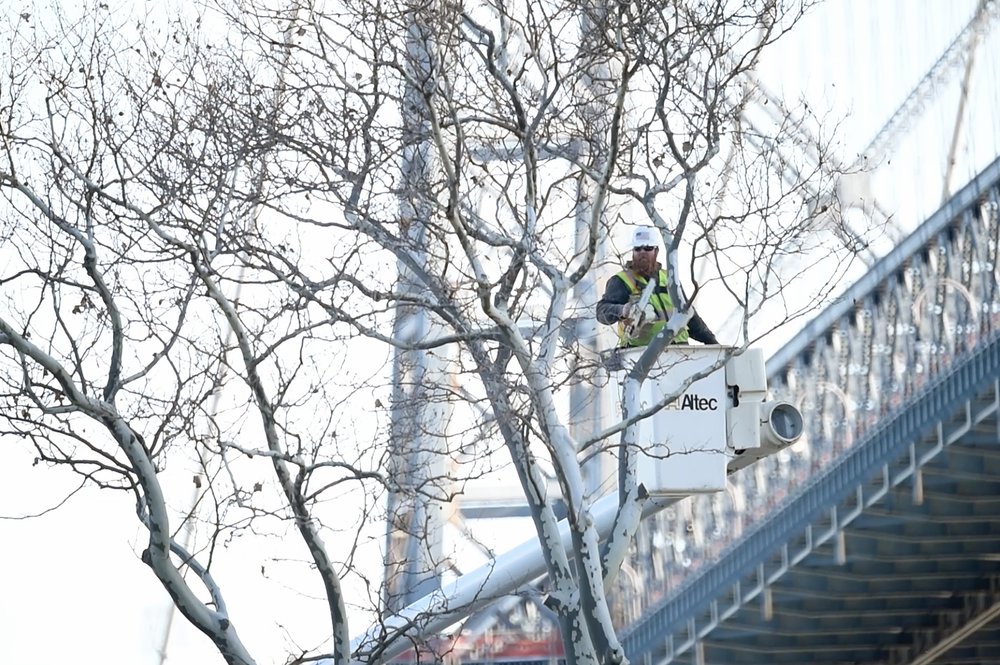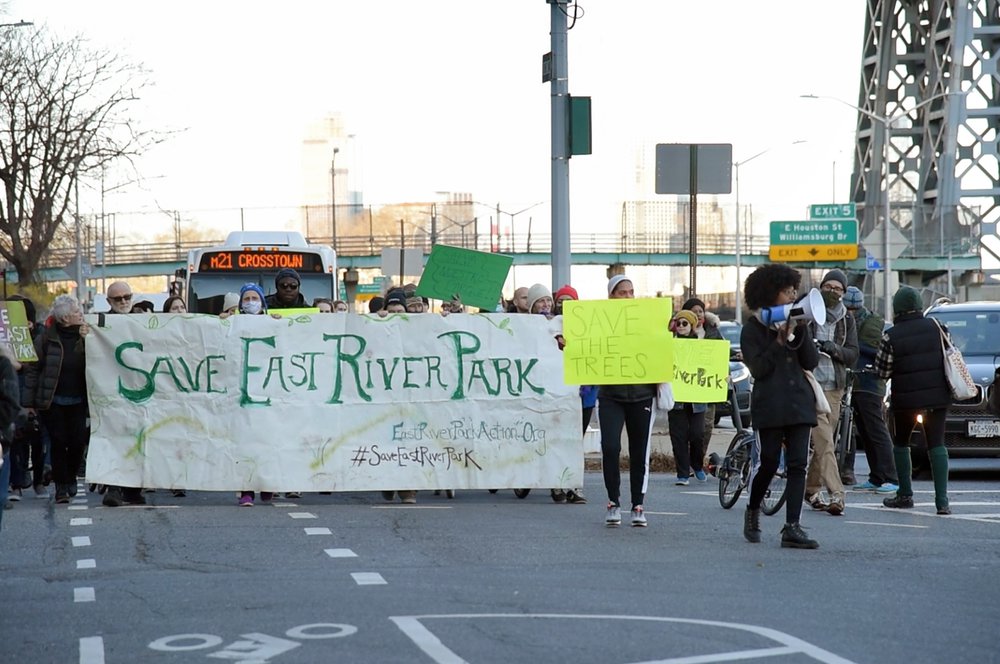PHOTOS: NYC Says Goodbye To East River Park
Dec. 31, 2021, 6 a.m.
The demolition of East River Park marks the last chapter in Mayor Bill de Blasio’s climate change legacy.
As sea levels rise and temperatures soar, New York City is facing a tenuous future shaped by the challenges of climate change. Hard decisions are now being made about which neighborhoods to protect and which to empty in a retreat from the waterfront.
Starting in early December, the final month of Mayor Bill de Blasio’s administration, the city decided to move forward on one of its largest climate infrastructure plans, the controversial $1.45 billion East Side Coastal Resiliency Project (ESCR). Demolition crews began working around the clock to eliminate the southern half of East River Park, operating throughout the weekend in defiance of a temporary restraining order issued by a state appeals court judge.
The rushed destruction of this much-loved 82-year-old waterfront park was met with immediate outrage, condemnation and protests. Under constant police protection, the workers continued to chainsaw hundreds of mature trees, rip out ballfields and tennis courts and demolish the park’s historic amphitheater. On December 16, the restraining order was rejected by an appeals court, giving the city a free hand. By then, the damage had already been done.
When complete, the ESCR project will remove the entire landscape of East River Park, destroying 991 trees and burying the park’s 57-acre footprint under eight feet of landfill. A new park will be built on top of this enormous storm surge barrier, including planting 1,800new, immature trees. The city expects this barrier will be completed in 2026 and that it will help protect the Lower East Side from storm surges until at least 2050. By then, if sea levels rapidly rise, the park may need to be demolished and raised again.

Over the past three weeks, the process of demolition at East River Park was rapid and brutal. Two teams using bucket trucks and chainsaws moved quickly and methodically through the park, hacking away at the tree canopy. Each team could strip a mature tree down to its trunk in a matter of minutes. Taken by surprise, squirrels fled from their winter nests, with broken branches raining down around them. Hawks and pigeons circled in the sky, looking for a place to land in the suddenly barren landscape.
Hundreds of towering trees, many of them at least 80 years old, were knocked over by bulldozers, yanked to the ground by teams of construction workers or chainsawed off at their bases. The Parks Department has stated some trees were unhealthy and damaged by saltwater, but much of the clearing just made way for the storm surge barrier’s footprint. At the amphitheater, the benches were ripped out by an excavator and the steps pulverized by a percussion hammer, reducing the seating area to a jumbled pile of lumber and broken concrete, before the bandshell was torn down.
RIP the East River Park Amphitheater, original site of Shakespeare in the Park; scene of the climactic hip-hop concert in WILD STYLE; & site of countless graduation ceremonies & music/dance/theater performances, restored after 9/11 but razed by the city... https://t.co/LKNVraSLRY pic.twitter.com/b7I1tWDe4H
— Mike Rubin (@rubinbooty) December 28, 2021
After being whittled down to a limbless trunk, the largest trees were cut off at the base and piled up with dozens of other stumps. Their branches and twigs were fed into a wood chipper. Hills of mulch grew along the northern boundary of the construction site, near the protestors, barricades and police cars. The ESCR project has bulldozed a vital habitat for dozens of species of birds, butterflies, and other species, just as winter is beginning.

Throughout the process, neighbors stopped by to mourn the loss of the park, which has been a family destination for several generations. Passersby shared stories about their high school graduation ceremonies at the amphitheater and hosting annual barbecues in the shady glens. Most did not know why the park was being torn down — or that an enormous storm surge barrier was planned to take its place. They also expressed confusion about why the city would demolish a thriving green space, in order to protect the community from climate change. The city plans to begin bulldozing the park’s northern half, above Houston Street, in 2024.

The first phase of work will eliminate the park’s southern half, which stretches along roughly a half-mile of waterfront between Stanton Street and Jackson Street. This section had several ball fields, a tennis center, a 20-year-old seal-themed water feature and the park’s amphitheater, which was originally constructed in 1941. Joseph Papp, an American theater icon and founder of Shakespeare in the Park, staged a free production of “Julius Caesar” at the amphitheater in 1956. The construction area will be closed to the public until at least 2023.
The original $760 million community-supported plan for East River Park would have raised a smaller section of the park, built berms and marshland, and installed floodgates on FDR Drive, which cuts the park off from the nearby neighborhood. De Blasio decided to scrap that process and move forward with his own more expensive plan in 2018, demolishing the entire park and burying it under 8 feet of landfill, with a new park on top.. The city claimed their plan would create a space that was better protected from major storm surges and that construction would be faster, with fewer disruptions to traffic on FDR Drive.
Their new plan was met with intense opposition. Protestors from the neighborhood, including the East River Park Action coalition, have described the city’s revised proposal as an environmental disaster and ecocide. They filed several lawsuits, slowing the process of design and construction incrementally, and hosted rallies, marches and protests at City Hall. But the city ultimately decided to push forward with the planned demolition, just as De Blasio exits office.

The de Blasio administration has left behind a decidedly mixed climate change legacy, and one of its largest shortcomings has been falling behind on billions of dollars of coastal infrastructure projects initiated in the aftermath of Hurricane Sandy. This last-minute destruction of East River Park has proved to be disruptive and lacks the transparency and safety measures usually seen at city demolition and construction sites.
Visitors to the park, including bicyclists, joggers, skateboarders and wheelchair-bound retirees, were left befuddled by the sudden closure of its southern entrances and paths.
No official construction signs, project descriptions or permits were mounted at the demolition sites. Clouds of dust rose up from the removal of the amphitheater’s aged concrete, behind a flimsy barrier of dilapidated fences and caution tape.
As one of the final acts of the de Blasio administration, the demolition of East River Park marks the last chapter in the mayor’s climate change legacy, ending his term on a controversial note, and leaving his successor with a messy process that will take years to complete.